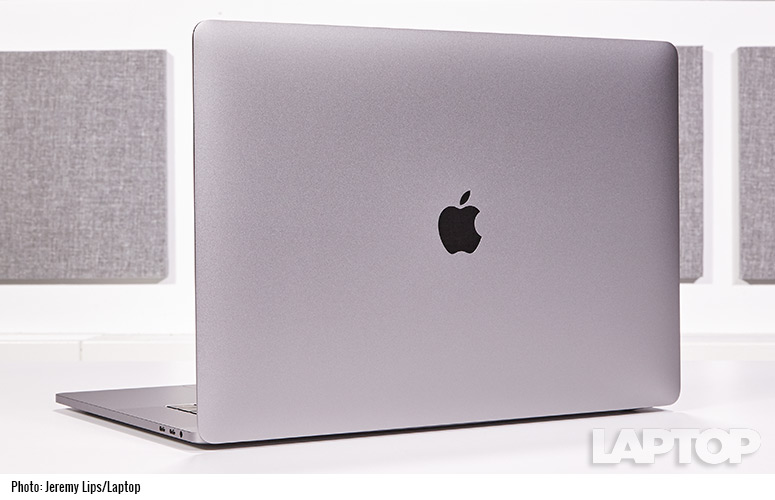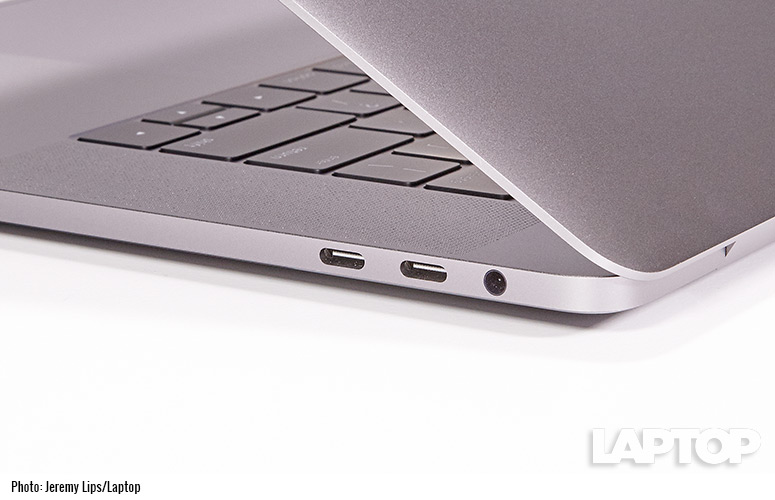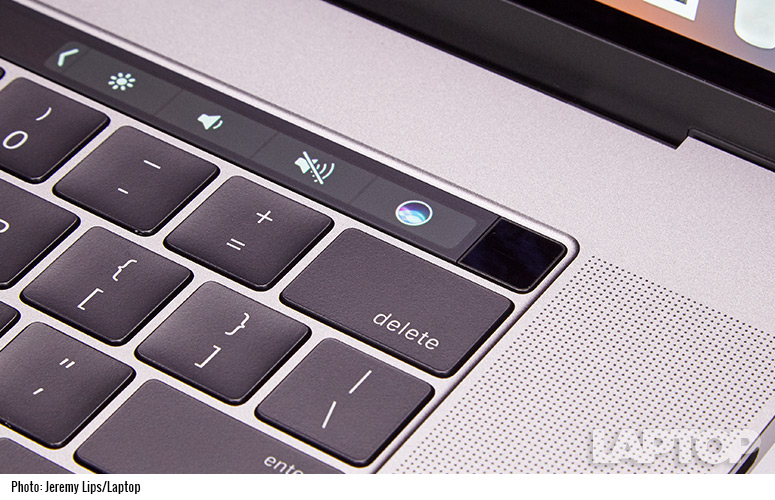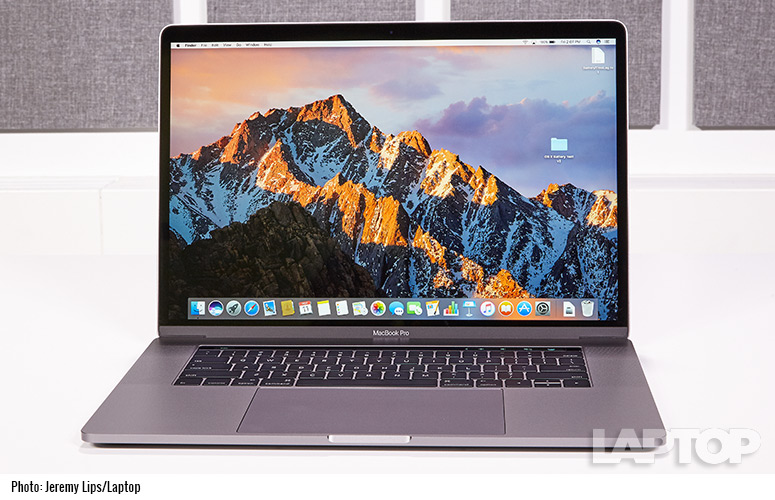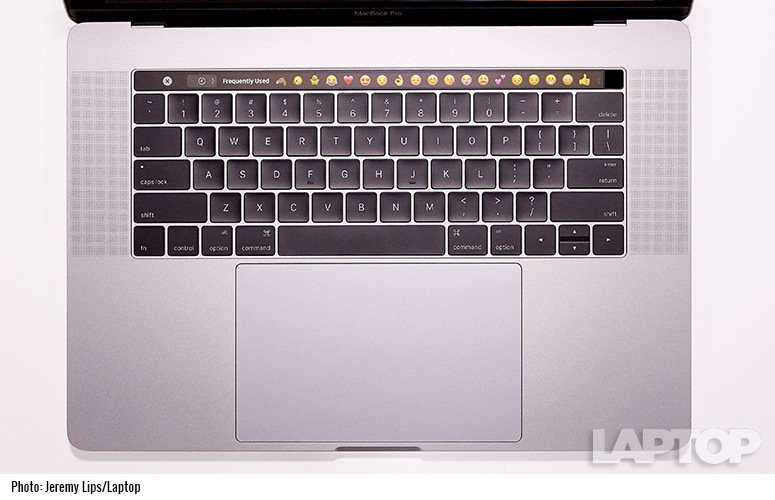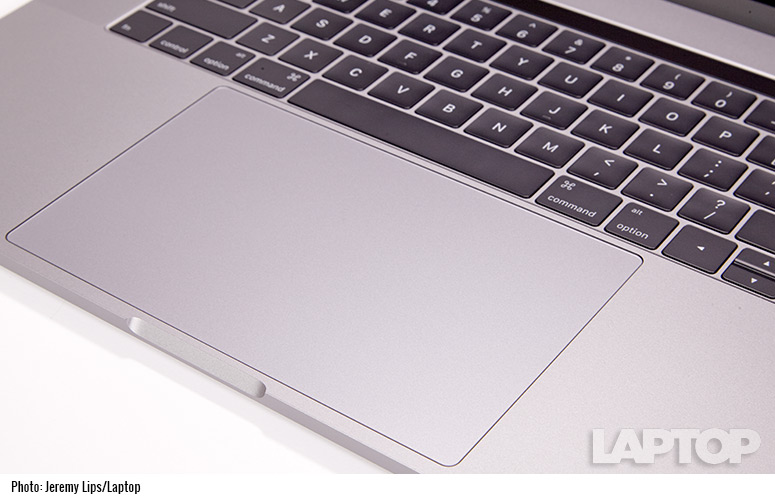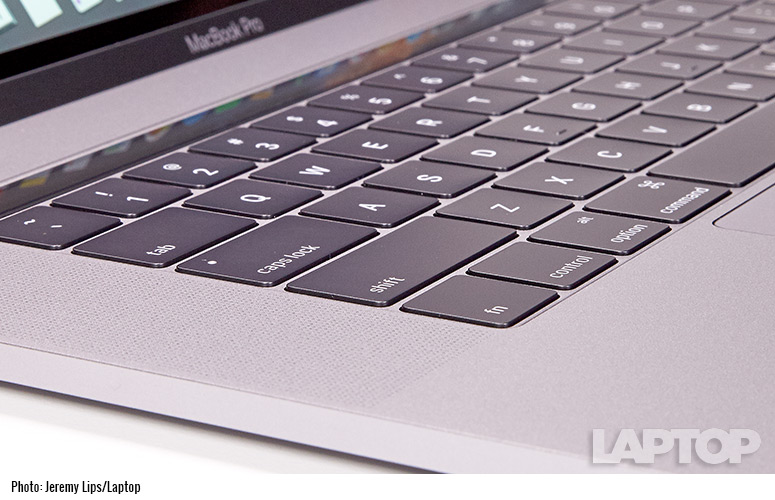Laptop Mag Verdict
The MacBook Pro with Touch Bar offers a slew of neat touch controls, a beautifully slim design and the most blazing performance you can find on a Mac.
Pros
- +
Innovative Touch Bar
- +
Gorgeous, slim design
- +
Rich Retina display
- +
Strong overall performance
- +
Snappy keyboard
Cons
- -
Lacks SD card slot, traditional USB ports
- -
Pricey
Why you can trust Laptop Mag
The 2016 MacBook Pro ($2,799 as reviewed, $2399 to start) isn't just a slimmer, more attractive and speedier refresh of Apple's laptop: it also changes the way you use the Mac. Thanks to the innovative new Touch Bar, you can do things like scroll through videos or tweak your GarageBand instruments without taking your hands off the keyboard, and can even log into the laptop with just your fingerprint.
These new features complement the most impressively-built version of Apple's pro-minded notebook yet, which sports an impossibly thin design, a gorgeous Retina display with improved contrast and blistering CPU and graphics performance. The new MacBook Pro's minimalist port selection could be a pain for folks who depend on lots of peripherals, but if you don't mind using a few dongles, you'll be treated to one of the best Mac experiences out there.
Design: An Air of Elegance
Nope, it's not a new Air -- the latest MacBook Pro really is that slim. What used to be the "chunky" laptop in Apple's lineup is now a gorgeous piece of machinery, with a sturdy, subtly-curved aluminum chassis and strikingly skinny edges that measure just 0.61 inches thin. I love the darker finish of our Space Gray unit, but you can also opt for a more traditional Silver coat of paint.
As a result of this redesign, the MacBook Pro is now thinner than Dell's XPS 15 (0.66 inches), the older MacBook Pro (0.71 inches) and Microsoft's Surface Book with Performance Base (0.9 inches). Apple's latest MacBook Pro is fairly portable at 4 pounds, and is lighter than all of those notebooks save for the 3.7-pound Surface Book.
Ports: Hope You Like Dongles
The MacBook Pro's newfound slimness does come at a cost. The notebook's only ports are a headphone jack and 4 USB-C Thunderbolt connections -- there isn't a single traditional USB 2.0 port or even an SD card slot. While this helps keep the Pro both thin and future-proof, it also means that using older accessories will be a pain.
Sign up to receive The Snapshot, a free special dispatch from Laptop Mag, in your inbox.
For example, if I wanted to charge my iPhone 7 on this MacBook Pro, I'd need a USB-C to Lightning cable, which Apple sells for $19. Want to use standard USB accessories? You'll need a $9 USB-C-to-USB adapter. And if you need to use SD cards (which I'd wager many creative professionals would), you'll have to get a USB-C SD reader such as the $29 SanDisk model Apple sells.
As neat as Touch Bar is, it doesn't feel like it's reached its full potential yet.
It's not a huge surprise to see Apple go minimalist with this MacBook Pro -- the 12-inch MacBook packs just a single USB-C port, and the iPhone 7 ditched the headphone jack in favor of a slimmer design and new features. But if you're a power user who relies on a myriad of peripherals and external monitors, using the MacBook Pro the way you want to could prove frustrating (and pricey).
MORE: Thunderbolt 3 Explained: Why You Need the World's Fastest Port
Touch Bar: Changing the Mac Experience
The MacBook Pro's function row has been replaced by the Touch Bar, a multi-touch LED strip that offers different sets of controls based on the app you're using. It also brings Touch ID to the Mac for the first time, allowing you to log in or authorize an Apple Pay payment with your fingerprint. While it needs some work to become a complete game-changer, the Touch Bar often makes using Apple's notebook easier -- and, in many cases, a lot more fun.
When you're typing notes, messages and web addresses, the Touch Bar will offer predictive text to finish your sentences just like the iOS keyboard does, and can even give you a row of emoji to choose from. I really enjoyed being able to bounce between Safari tabs with a quick tap of the bar, and liked that I could flip through my Photos library just by running my finger along it.
MORE: Best Touch Bar Apps for Your New MacBook Pro
I can see heavy creative users getting a lot out of Touch Bar -- in GarageBand, for example, you can use the strip to quickly change the volume and EQ settings of your active instruments. While using iMovie, I used the bar to instantly split up video clips and quickly fast forward and rewind my movies. The Touch Bar often lets you perform tasks that are typically mouse-based without taking your hands off the keyboard, which could prove invaluable for those looking to get their work done even faster.
The Touch Bar still provides access to the brightness, volume, media playback and window-swapping controls that used to be mapped to the function row. And if you miss your old F1 through F12 keys, holding down the function key will provide virtual versions of those on the Touch bar.
Touch Bar seems to be Apple's response to the full-on touch displays of its Windows competitors, but whether it's a better solution is hard to say. If you want a laptop that lets you draw illustrations or simply jot down a few meeting notes, the Touch Bar isn't going to do that for you; the Surface Book is better for that. But if you want more virtual buttons for things like video editing and music production, Apple's LED strip is uniquely useful. I don't typically get much use out of a touchscreen on a non-convertible Windows laptop, but I did find myself frequently using the Touch Bar to finish my sentences or go to my favorite web pages.
Packing improved brightness and contrast over previous models, the MacBook Pro's Retina display is more droolworthy than ever.
As neat as Touch Bar is, it doesn't feel like it's reached its full potential yet. When using Chrome, for example, I was bummed that I didn't have the same tab-switching controls that I did in Safari. Touch Bar is open to third-party developers, however, and there's already several options available. These include Microsoft Office and Outlook, Skype and Pixelmator, with support for tools like Photoshop, design app OmniGraffle and blog tool Blogo coming soon.
Display: Bright and Beautiful
Packing improved brightness and contrast over previous models, the MacBook Pro's 15.4-inch, 2880 x 1800 Retina display is more droolworthy than ever. I marveled at each tiny ridge of the snowy Sierra mountains on the laptop's background, and on-screen text looked like it came out of an inky pen.
The notebook made an excellent showpiece for the Star Wars: Rogue One trailer -- I could spot every tiny wrinkle on Director Krennic's face, and everything from the tropical beaches of Scarif to the red and green lasers of a space battle burst with color.
The MacBook Pro's strong color performance was backed up by our lab tests. The notebook reproduced 116 percent of the sRGB color gamut, with a Delta E accuracy rating of 1.33 (closer to 0 is better). The Dell XPS 15's 15.6-inch 4K display had a weaker gamut showing (71.9 percent) but was more accurate at 0.7, while the Surface Book's 13.5-inch, 3000 x 2000 screen was similarly colorful (112.6) and even more accurate at 0.63.
The Pro is more than luminous enough for work and play, turning in a strong average brightness of 440 nits on our light meter. That tops the Surface Book (376 nits), the XPS 15 285 nits) and our 301-nit average for mainstream notebooks.
MORE: Which MacBook Should You Buy? MacBook vs. Air vs. Pro
Audio
I typically use headphones on laptops to avoid their usually tinny sound quality, but I could listen to music on the MacBook Pro's wonderfully booming speakers all day.
The notebook filled my entire bedroom with the rollicking metal-punk of Sum 41's "Fake My Own Death," giving a big punch to the song's piercing guitar riffs and allowing me to clearly hear the rich vocal harmonies of the chorus. The speakers proved just as impressive for movies, as the explosions and blaster fire of the Rogue One trailer sounded full and satisfying.
Keyboard and Touchpad
The new MacBook Pro uses the same super-flat butterfly keyboard as the 12-inch MacBook. It feels shallow at first touch but is surprisingly satisfying. The notebook's 0.5-millimeter keys felt snappy, responsive and comfortable, allowing me to zip through the Key Hero typing test at a speedy 97 words per minute (which is about my norm) with only a 2 percent error rate.
The Pro's 6.1 x 3.9-inch trackpad looks comically large on this new model, but I enjoyed having plenty of space to pinch to zoom or use multi-finger gestures to flip between windows. The MacBook Pro features the same Force Touch trackpad found on most of Apple's recent notebooks, using haptic feedback to simulate the sensation of a physical click while opening up some cool pressure-sensitive capabilities.
For example, you can hard-press on a website link to preview the page before opening it, or fast-forward through iMovie videos faster by pressing down harder on the pad. It takes a bit of getting used to, but having used Force Touch for a while now, I have no desire to go back to plain-old physical click buttons.
Performance
Packing a 2.7-GHz Intel Core i7 processor and 16GB of RAM, our MacBook Pro is a multitasking monster. The system never slowed or crashed no matter what I threw at it, even as I bounced through more than a dozen browser tabs, downloaded a game, watched two Twitch streams and played some piano in GarageBand all at once.
The MacBook Pro turned in a scorching 13,215 on the Geekbench 4 general performance test, trouncing the Surface Book (7,559) and our 6,518 category average.
Our MacBook Pro's 512GB PCIe-based SSD copied about 5GB of data in a zippy 7 seconds, for a transfer rate of 727.04 MBps. That smokes the Surface Book's 1TB PCIe drive (363.5 MBps), the XPS 15's 512GB SSD (254 MBps) and our 170 MBps average.
Graphics
Our MacBook Pro features discrete AMD Radeon Pro 455 graphics, making it ideal for video editing, design work and some light gaming. The notebook ran racing game Dirt 3 at full HD at a silky 60 frames per second, nearly doubling our 32-fps mainstream notebook average while trailing the Nvidia GTX 965M-powered Surface Book (117 fps)
The Pro reached a smooth 79.84 on the Cinebench OpenGL graphics test, which renders a virtual car chase scene. That puts it about on par with the Surface Book (78.5) and far ahead of newer integrated Intel graphics systems such as the HP Spectre x360 (43.80) and Dell's smaller XPS 13 (42.62).
The MacBook Pro scored a 42,211 on the Geekbench 4 compute test, which also factors in GPU performance. That trails the new Surface Book (63,900), but tops the Spectre (19,476) as well as the Iris Pro-based 13-inch MacBook Pro (30,628).
The MacBook Pro is well-equipped for a long day of working on the road -- and not just because of its slim size.
Software: Better With Siri
The MacBook Pro runs on the latest macOS Sierra software, which adds some handy features to Apple's strong software suite and clean, bloat-free interface. The MacBook finally utilizes Siri, which allowed me to visit websites, check the weather, initiate text messages and activate iTunes all with my voice. Siri consistently heard my queries correctly, and I'm not sure I can go back to using a Mac without her.
With Sierra, you can also now use Apple Pay right from your Mac, as well as unlock the laptop hands-free by using your Apple Watch or iPhone. Other neat extras include a picture-in-picture mode for watching videos while taking notes, as well as the ability to access your MacBook Pro's desktop from another Mac.
Webcam
The MacBook Pro continues to have one of the best laptop webcams out there, capturing colorful shots that preserved my skin tone and the finer details of my thick beard. As on any MacBook, you can play with a variety of fun filters and backgrounds via the Photo Booth app.
Battery Life
The MacBook Pro is well-equipped for a long day of working on the road -- and not just because of its slim size. Apple's notebook lasted an excellent 10 hours and 32 minutes on our battery test (continuous web surfing over Wi-Fi), which is longer than the Dell XPS 15 (6:35 for 4K, 10:26 for 1080p) the Surface Book (9:10) and our 8:05 average.
Heat
You won't have to worry about the MacBook Pro burning a hole through your lap. After streaming 15 minutes of HD video, the notebook's touchpad, keyboard and underside measured in at 81, 88.5 and 89 degrees, respectively. All of those temperatures are under our 95-degree comfort threshold.
Configurations
The 15-inch MacBook Pro with Touch Bar starts at $2,399 and packs a 2.6-GHz Core i7 processor, a 256GB PCIe SSD, Radeon Pro 450 graphics and four USB-C ports. The higher-end Touch Bar model that we reviewed costs $2,799, which features a 2.7-GHz Core i7 processor, a bigger 512GB PCIe SSD and Radeon Pro 455 graphics.
If you can live without the Touch Bar, the previous-gen version of the 15-inch MacBook Pro costs $1,999 and packs a 2.2-GHz Intel Core i7 processor, 16GB of RAM, a 256GB SSD, Intel Iris Pro Graphics and two USB-C ports. This version only comes in Silver.
Bottom Line
If you're willing to pay a premium for it, the Touch Bar-enabled MacBook Pro ($2,799 as reviewed) is the best version of Apple's high-end notebook yet. The innovative LED strip already has a variety of practical (and plain fun) uses for creators, and it has the potential to get even better once third-party developers embrace it. It doesn't hurt that the latest Pro is also thinner, faster and more vibrant than before.
However, some power users may find the new Pro to be too minimalist, as you'll need a variety of dongles just to use SD cards and older USB accessories on it. The starting 15-inch Touch Bar model is a hefty $400 more than a non-Touch MacBook Pro, which itself costs $1,999.
If you're cool with Windows, Microsoft's 2-in-1 Surface Book with Performance Base ($2,399 starting) is a better pick for folks that like to draw and jot down notes, and Dell's super-slim XPS 15 offers a 4K touchscreen for $2,100. But if you're a Mac loyalist looking for something that will help you get work done on an all new level, the new Touch Bar model could be exactly what you're looking for.
Apple MacBook Pro 15-inch 2016 Specs
| Brand | Apple |
| CPU | Intel 2.7-GHz quad-core Core i7 (6th gen) |
| Company Website | www.apple.com |
| Display Size | 15.4 |
| Graphics Card | AMD Radeon Pro 455 with 2GB |
| Hard Drive Size | 512GB |
| Hard Drive Type | PCIe SSD |
| Native Resolution | 2800x1800 |
| Operating System | macOS Sierra |
| Ports (excluding USB) | USB Type-C, Headphone |
| RAM | 16GB |
| RAM Upgradable to | 16GB |
| Size | 13.75 x 9.48 x 0.61 inches |
| Touchpad Size | 6.1 x 3.9 |
| Video Memory | 2GB |
| Warranty/Support | one year limited-warranty |
| Weight | 4 pounds |
| Wi-Fi | 802.11 a/b/g/n/ac |

